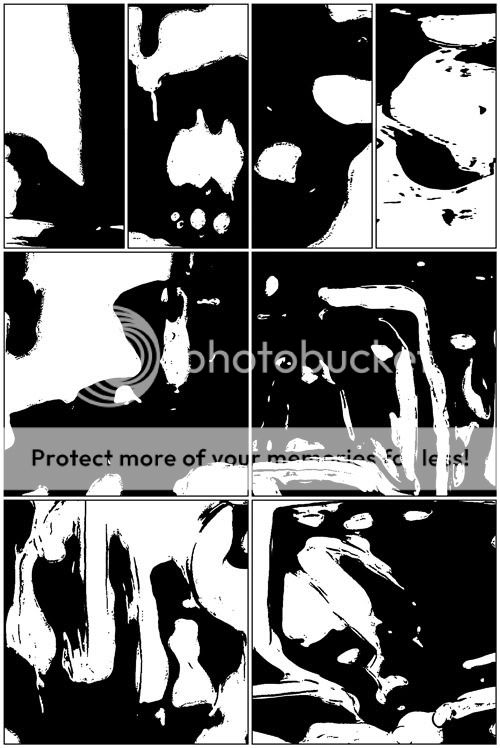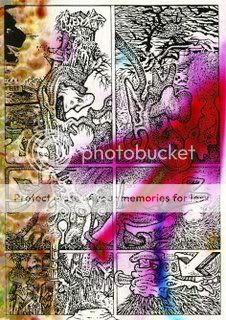In the unlikely event that you read all the comments on this blog, you’ll have seen that artist and curator Andrei Molotiu recently contacted me about my “abstract comics”. I was flattered by his interest, but also a little taken aback. Though I’ve been doing some abstractions based on comics, I really thought of them as drawings ( meant to be shown in a gallery, if I’m lucky), rather than as comics (meant to be mechanically reproduced and placed in an anthology, if I’m lucky.)
In fact, I have a lot of doubts about “abstract comics”, both as a meaningful category and as an aesthetic project. It seems to me that when comics become abstract, they really cease to be comics and become, for all effective purposes, simply abstract art. One can argue back and forth about whether “sequential art” is the best possible definition of comics, but it’s certainly true that comics relies for its existence on relationships — between image and image and/or between image and text. Abstraction is based on removing relationships and referents — you can no longer tell how you got from panel A to panel B; in fact, in many cases, you can’t even separate panel A from panel B. But when you remove the relationships, you remove the comics. You’re left with a drawing, which exists most comfortably within the visual art tradition, rather than within the tradition of comics.
There are various ways around this. You can try to do to comics what writers like John Ashberry have tried to do to language — that is, break down the connections between individual units in such a way that the juxtaposition of terms becomes evocative or mysterious in a way that approximates abstraction. (Some of Fort Thunder’s stuff works like this…or even some of R. Crumb’s trippier sixties layouts.) Or, alternately, you can adopt some of the tropes of comics (panel borders, speech bubbles, motion lines, etc.) into your drawing, so that the abstract art starts to look like a comics page.
I actually like all of these examples. Andrei’s piece below, for example, uses the panel grid to give a sense of time passing — amorphous shapes oozing and refracting in a landscape that never quites take form. It’s a nifty half-way point between abstract art and abstract film, which ties in with the Winsor McCay/Chris Ware tradition of page composition.
And I also admire the piece below by Zeke Clough, a very talented artist who I believe still hangs at my old group blog, Eaten By Ducks. Anyway, the drawing is very Gary Panter-like in using the panel borders as a stable background which emphasizes the drooling messiness of the drawing (and the sloppy ichorish colors as well.)
But though I can like individual examples, I still kind of distrust the overall project. Using abstraction as juxtaposition really works best the less abstract you get — which is compared to Wallace Stevens (who is much more willing to risk actually saying something), John Ashberry comes across as boring and pompous. And it’s awfully hard to use elements like panel borders or speech bubbles and motion lines without looking condescending or nostalgic or both. You end up, basically, attempting to validate the comics by turning them into contentless high art, or attempting to validate the high art by making it cute or fun. It’s like classical musicians playing pop hits: the smirking gets so loud it’s all you can hear.
Of course, I do abstract drawings myself, and part of this is me trying to work through what I do or don’t want to do with my own art. Anyway, if you’d like to hoist me on my own petard, you can see the drawings that Andrei was interested in here and here.



Lewis Trondheim’s Bleu is an interesting example of abstract comics that does not use panels or word balloons or much in the way of representation, but can still be read as a comic.
My post on it:
http://madinkbeard.com/blog/archives/bleu-by-lewis-trondheim
Hi Noah! I just noticed that you are in my old home town of Chicago. Good luck there! Come and see some of what I rant on about, often in relation to Chicago, the artworld and comics, at http://www.sharkforum.org.
While I appreciate the forthrightness of your blog here (very much!), I think you have misunderstood a major point. It IS comics if it uses the language (the important elements thereof), whether abstract or not : e.g. closure, sequentiality, “camera” angles and so on. I gave a big ole speech about this at the art historians conference 2 years ago in relationship to my own “fine” art, paintings and installations, which are usually (although not always) comics in this sense. You can peruse my over long article here if you’d like (http://www.markstaffbrandl.com/CAA/CAA_brandl_pcv.html)
While such “expanded” comics are usually made for display, thus “gallery comics” in C Hill’s terminology, they are still comics when using the language (or “toolbox” if you will) in an integral fashion. This may not always be immediately obvious, but with a little work should be retrievable — as in Andrei’s excellent works. His, like mine, often emphasize what I have termed “iconosequentiality” (like Frank King’s genius all-one—and-set-many-images comics) (which I have discussed here http://www.sharkforum.org/archives/2006/05/two_new_art_terms_a_new_artist.html), nonetheless, they are comics. If such a work as mine or Andrei’s et al. only “cites” comics a la Lichtenstein or Warhol, then it is decidedly NOT comics. Which is not to say that it is not good, but it is not a comic. It is a representation OF a comic, in many ways. A fully abstract work also citing comics, such as a painting by NIcholas Krushenick, whose work I love, is also NOT a comic, albeit comic influenced. there is a philosophical / ontological difference. But a work can certainly be abstract AND a painting AND an installation AND a comic and more, if so conceived.
“Madink” who comments above has understood this well and discussed it on various occasions on his excellent site.
Hey Mark. I’m afraid I’m not entirely convinced. My point is that, despite the use of various comics techniques, the tradition of abstract art seems to me, for a lot of these pieces, to be much more powerful. In other words, whatever the intention, and whatever the use of comics tropes, the piece ends up looking like a piece of abstract art with comics bits tacked on for reasons which seem aesthetically dubious.
You seem to think that something can be comics in a platonic sense. I have a much more historical take on definitions like that. It’s about how a given piece fits into a tradition (or traditions). These lines are always arbitrary anyway, but they can be negotiated more or less successfully.
I have seen sharkforum; y’all reviewed some of my art a while back, actually.
No, I am completely non-Platonic in any real philosophical sense. (I’m actually a Pragmatic Gadamerian addict of Cognitive Metaphor, to get all filosofy fancy-pants-talkin.) I am proposing no “ideal” manifestations or the like.
I am simply talking in definitional terms, which for me also strongly includes the “tradition,” I think you are right-on there, — I would say you are being far more quasi-Platonic/categorical in your insistance on a clear separation of comics and fine art traditions. Ontology (definition) is not necessarily Platonic.
You dfintion of comics seems, again, more rigid than mine or Andrei’s in that yours mandates narrativity.
I am also NOT talking about using comic “tropes” or metaphors, but the techniques of the genre/medium which are integral to its definition and existence. (Comics IS a bastard form, I realize, thus making us both right, really, but I hope you get my drift… for instance, I think it is a darn shme that the techniques of comics often get discusssed as if they were a copy of or metaphor for cinematic techniques, when many of said elements apperaed in comics FIRST before film took them on…)
And oh yeah, that review was of work you had at Dogmatic, right? I wish he had described more and shown more of your work. The very short description intrigued me, but wasn’t enough!
Yeah, yeah, Noah, whatever. Just gimme the art.
Fair enough, Andrei. You’re the one who wants the artist statements, though….
Mandei muitos e-mails para Alex tirando duvidas e ele respondeu a todos com muita dedicação, agora deu tudo certo estou
mega feliz pois agora está sublimando perfeitamente, e já estou partindo
para curso da silhouete!